Today’s Fed (FOMC) meeting: What to expect
Market expectations for the March FOMC meeting: Will the Fed raise interest rates or opt for a pause amid uncertainty and financial turmoil?

Policymakers face the challenge of predicting economic growth and inflation in a highly uncertain environment, but the costs of inaction, given the current elevated levels of inflation, outweigh any potential benefits.
The Federal Open Market Committee (FOMC) is expected to increase the federal funds rate by 25 basis points, from 4.75% to 5.0%.
If the Fed decides to pause interest rates, it will accompany a hawkish dot plot and indicate more rate hikes likely after the current financial turmoil subsides.
FOMC to address US bank crisis and Eurozone inflation hikes.
The Federal Open Market Committee (FOMC) is expected to address the two major crises currently affecting the US and Europe. America is responding to fragility in the banking sector, and the Eurozone is battling increasing inflation rates. At a recent press conference, ECB President, Christine Lagarde, stated that there is no tradeoff between financial stability and price stability, which means that separate tools will be needed to address each issue. Fed Chair, Jerome Powell, is likely to take notice of this sentiment and may express a similar view at the upcoming March FOMC meeting. Lagarde also commented that the ECB has more extensive facilities than the Fed to address these concerns, if deemed necessary. However, the FOMC is expected to share the sentiment of “no financial-stability tradeoffs”. New York’s Fed president, John Williams, has advocated for using interest-rate policies to address the dual mandate of price stability and maximal employment – as given the current inflation hikes, it would not be the right time for the Fed to back down.
FOMC expected to announce 25 basis point hike
Today’s FOMC meeting is expected to be a particularly difficult one, with market expectations having fluctuated considerably over the past week. Initially, there was anticipation of a 50-bp hike after Fed Chair Jerome Powell's testimony to Congress, but this shifted to a pause as turmoil surrounding Credit Suisse intensified. Despite this uncertainty, the dominant market view at the time of writing is that the Fed will raise rates by 25 bps, taking the upper bound of the fed funds rate from 4.75% to 5.0%.
The FOMC is expected to increase the fed funds rates by 25 bps to a range of 4.75%-5.0%, with inflation still high and interest-rate policy deemed essential for the Fed's dual mandates of price stability and full employment – but as inflation is still too high, a 25-bp hike as slightly more plausible.
Several FOMC members have emphasized that interest-rate policy should be used primarily for the Fed’s dual mandates of price stability and full employment, not for financial stability. Financial instability would therefore need to be addressed with other tools, such as the emergency bank term lending facility announced on 10th March 2023.
Although there is a possibility of the committee pausing to evaluate the situation and signaling a higher peak rate through the updated Summary of Economic Projections, it is more likely that the Fed will opt for a 25-bp hike. If a pause does occur, it will be accompanied by a hawkish dot plot, indicating that it is only a temporary change of tactics with more rate hikes likely after the financial turmoil subsides. The dot plot is expected to show a peak fed funds rate of 5.5% in either scenario.
How interest hikes could require revising growth forecasts.
A further hike in interest rates could exacerbate the prevailing risk-off sentiment. The recent financial turmoil is expected to prompt most participants to revise and depreciate their growth forecasts. However, any such revision could be counterbalanced by upward revisions based on the economy's momentum prior to the collapse of SVB. It’s also possible that there will be a marginal downward revision to the real GDP growth rate for 2023 at 0.4%, down from the 0.5% projection in December’s SEP. Conversely, unemployment could experience a revision downwards to 4.4%, from the previous 4.6%, buoyed by the strength of Non-farm Payroll (NFP) labour data shared in January and February. Nonetheless, core PCE inflation is expected to undergo an upward revision throughout the forecast horizon, projected to reach 3.7% (from 3.5%) in 2023, 2.7% (from 2.5%) in 2024, and 2.3% (from 2.1%) in 2025.
As a result of the projected upward revision to inflation, and downward revision to unemployment, the median participant is expected to raise their estimate for the peak fed funds rate with the figure climbing to 5.375% (which translates to an upper end of 5.5%).
Powell expected to confirm ECB sentiment.
In a move akin to European Central Bank’s President Christine Lagarde, Federal Reserve Chair Jerome Powell is expected to express confidence in the resilience of the banking system and highlight the Fed's diverse set of tools for addressing financial stability concerns. Regardless of whether the Federal Open Market Committee opts to raise interest rates by 25 basis points or maintain the status quo, the central bank remains steadfast in its commitment to returning inflation to its 2% target, an unwavering goal. Ultimately, policymakers face a complex decision, evaluating the advantages and drawbacks of each potential course of action. However, it could be expected that the Fed will ultimately conclude that the costs of inaction, given the current elevated levels of inflation, outweigh any potential benefits, leading to a decision to raise rates by 25 basis points.
“There is no tradeoff between financial stability and price stability” – Christine Lagarde, ECB President.









